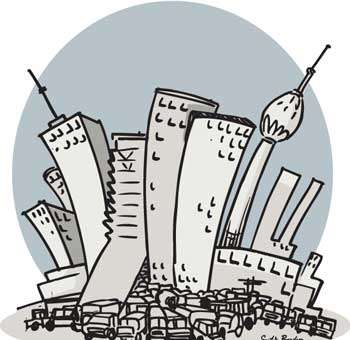Reply To:
Name - Reply Comment
 Even if I knew that tomorrow the world would go to pieces, I would still plant my apple tree– Martin Luther King
Even if I knew that tomorrow the world would go to pieces, I would still plant my apple tree– Martin Luther King
If taken either literally or metaphorically King’s quote has a lesson for all. Here in Colombo as the skyline changes every passing day with bare tall buildings dwarfing the shorter, old ones the pertinent questions one would ask are ‘where is the replenishment for the trees felled?’. Where are the green lanes and space for ecological balance? Have the government, local bodies and the private sector forgotten the green factor?
Similar building booms with scant regard for ecology and essential facilities saw cities like Rio de Janeiro, Manila and Mexico City, turning the most unsustainable metropolises on earth. One wonders whether Colombo is fast following them. After all just like Colombo both Rio and Manila are sea front cities.
Anyone travelling to Colombo from Kandy, Negombo, Avissawella, Horana or Kalutara will pay witness to the phenomenon of every peripheral city in the province merging the other thus turning the entire western province into one big city. There are only a handful of villages left in between the townships and green patches and tree lines are fast becoming a rarity. The paddy fields and rubber lands have been taken over by the real estate companies. Call this urbanization or development but who decides what is suitable or not or the balance between development and ecology?
Vihara Maha Devi Park (Victoria Park) which was opened in 1951 remains the only major green patch in Colombo district and no plans have been made to open any other large park ever since. If at all if there’s any shade other than that it’s provided by the old tree lines in Colombo 7 which too date back to the same era.
As for sanitary facilities, sewerage issue in Colombo and suburbs has reached a crisis point and with a chunk of new buildings hiring sewerage bowsers to empty pits regularly in the absence of their own treatment plants. As of now all the sewerage lines of Colombo National Hospital are open to Beira Lake and the plush new city of Colombo Fort is being built around this lake of epidemics.
Meanwhile, despite repeated requests no major repairs have been done at Ambatale water plant and already the city is having issues with the water supply. As to how to cater to the rapidly increasing water demand in the next few years is anyone’s guess. Besides deep earth drilling for high rising buildings has gone to block underground waterways and home wells are fast becoming a thing of the past.
It’s true that decades of poor planning has left little space for manoeuvring for the incumbent government. However still it’s obvious that unless all government agencies attending to infrastructure, amenities and facilities meet and have a brainstorming session and work together to address the crisis the situation is only going to turn for the worse. Right now what is happening is each government agency working independently is sometimes even at cross purposes and overlapping of duties.
As for making Colombo a greener city given the manner desert cities like Dubai have resorted to innovative moves to increase the greenery it’s not wrong to say one can do wonders with the fertile soil of Sri Lanka if the government and private sector are genuinely committed to the cause. Given the number of government ministries and private entities involved in the building boom it is obvious that unless there’s a move by the political leadership it will be difficult to muster unanimity to make Colomboa greener city.
The only redeeming factor in the city perhaps is its relatively high standard of the air quality. According to a Yale university study the mandatory emission test introduced in 2008 by then Environment Minister Patali Champika Ranawaka has resulted in Sri Lanka performing way ahead of other nations in the region in terms of air quality.
Progressive, wholesome steps yield good results. Sri Lanka surely has to find a way out of the current mess before it’s too late.